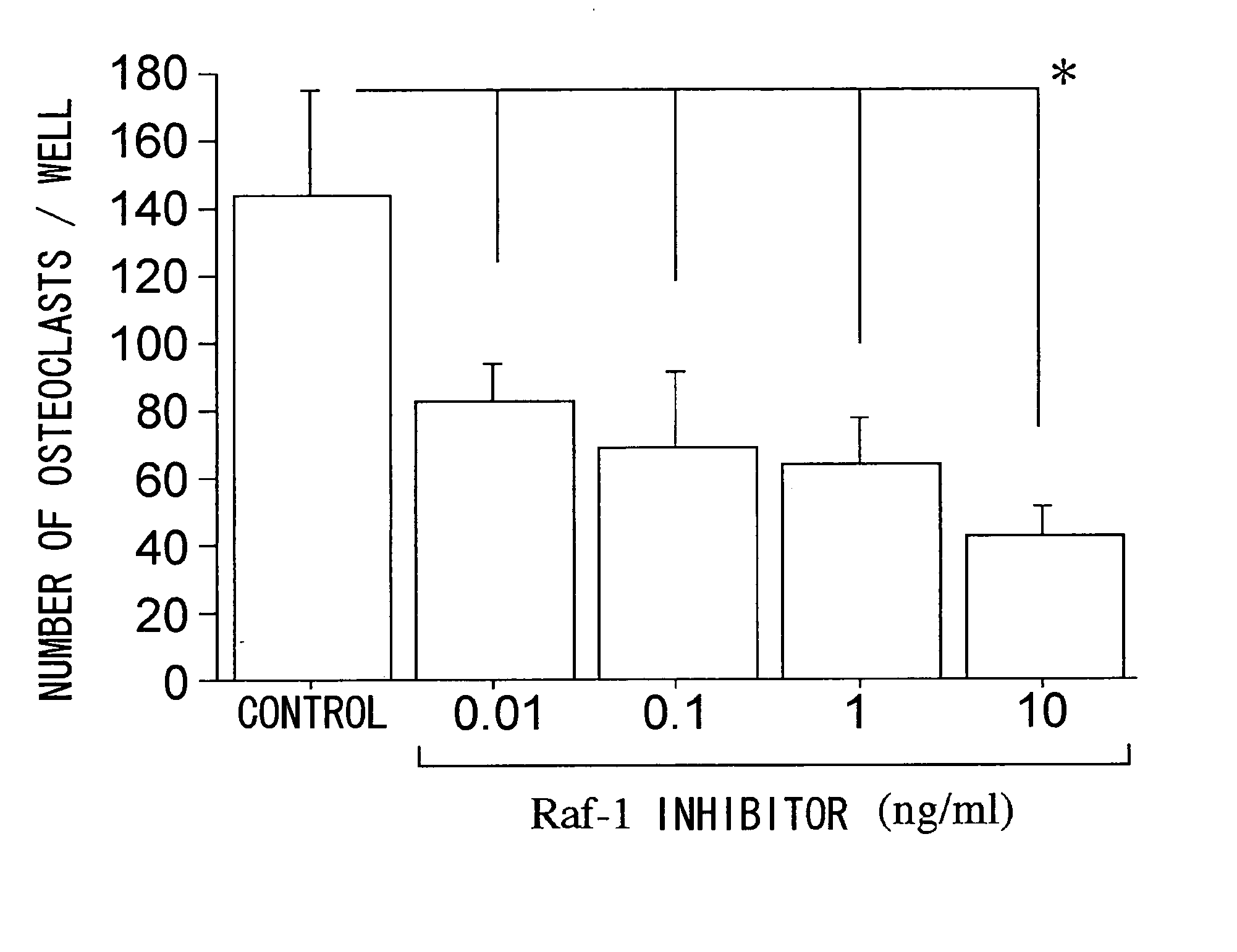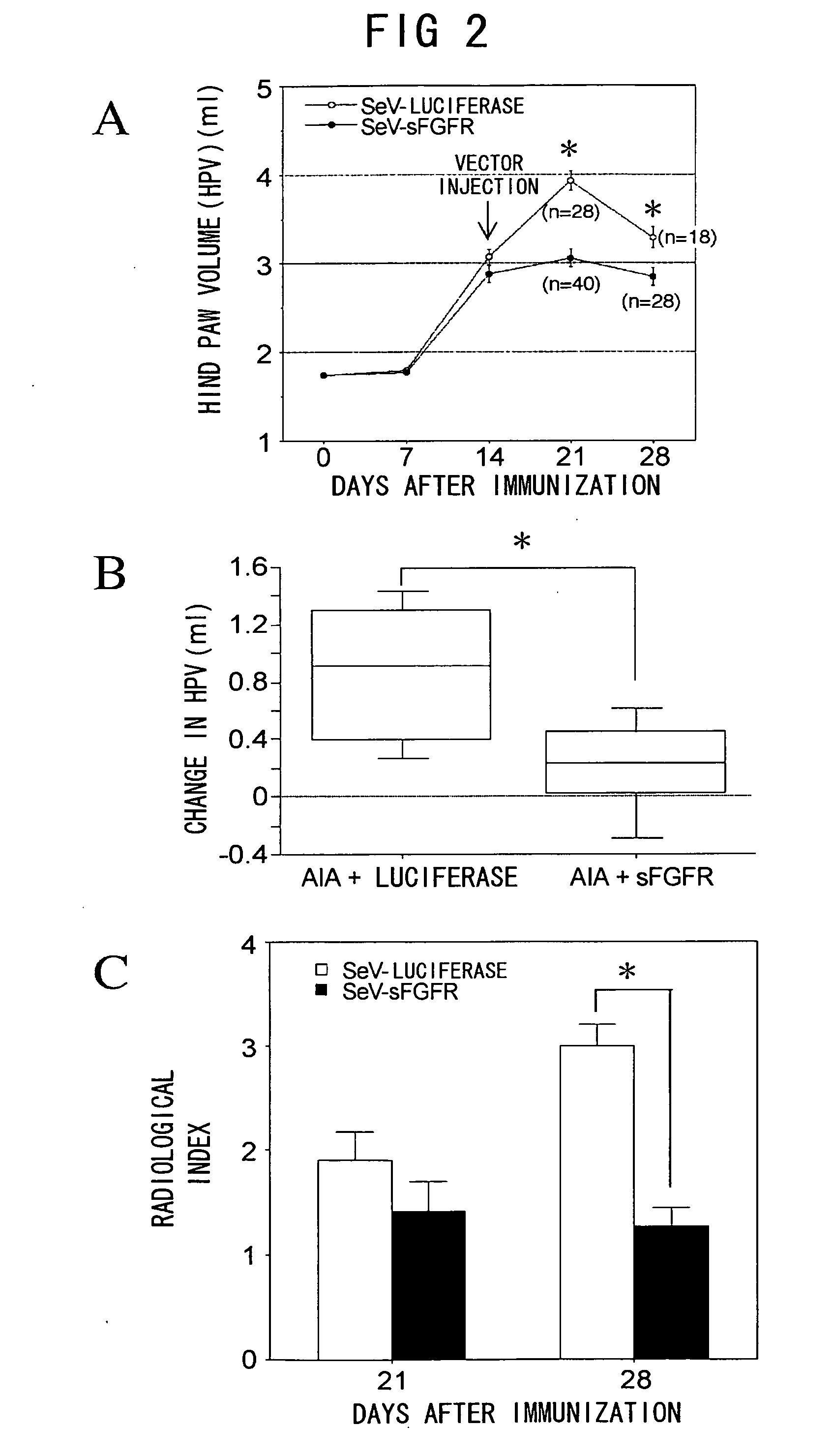Methods of treating inflammatory diseases associated with bone destruction
a technology of inflammatory diseases and bone destruction, applied in the direction of drug compositions, peptide sources, peptide/protein ingredients, etc., can solve the problems of no effective treatment methods for inflammatory diseases, and achieve the effects of suppressing the development of synovitis, preventing protein concentration, and preventing the formation of high concentration
- Summary
- Abstract
- Description
- Claims
- Application Information
AI Technical Summary
Benefits of technology
Problems solved by technology
Method used
Image
Examples
example 1
Effect of Raf Inhibitor on Cultured Osteoclast Formation
1. Isolation Culture for Rat Bone Marrow Derived Macrophages
[0053] Isolation culture for rat bone marrow derived macrophages was performed using macrophage colony stimulating factor (M-CSF). Eight Charles-River grade Lewis rats (six weeks old, KBT Oriental Co., Ltd., Tosu, Saga) were used, and sacrificed by cervical dislocation under anesthesia, and the carotid artery was dissected to remove blood. Bone stem from both the femur and tibia was removed under sterile conditions, and myeloma cells were collected by injecting culture media (α-modified essential medium: α-MEM (GIBCO BRL, Rockville, Ma. USA) into the medullary cavity of the bone. Erythrocytes were washed with 0.727% NH4Cl-0.017% Tris-Cl(pH7.2)-phosphate buffered saline (PBS) solution, and then 5×106 cells were dispersed in a 180 ml flask using α-MEM comprising 10% fetal bovine serum (FBS) and recombinant human M-CSF (rhM-CSF, 10 ng / ml, CHEMICON International, Inc. ...
example 2
Effect of sFGFR Gene Transfer on AIA: Extracellular Blocking of FGF-2
1. AIA Model
[0055] For the AIA model, rats were injected subcutaneously at the base of the tail with 1 mg Mycobacterium Butyricum Desiccated (MBD, Difco, Detroit, Mich., USA) dissolved in 100 μl mineral oil (NACALAI TESQUE, Kyoto).
2. Experimental Protocol for Extracellular Blocking of FGF2
[0056] The target gene was expressed in rats at the inflammation site by direct gene transfer methods using recombinant Sendai virus vector (SeV), and the effect on arthritis was examined. Specifically, after arthritis development was confirmed, SeV carrying soluble FGF receptor gene (sFGFR, SEQ ID NO: 1) (SeV-sFGFR) was administered to the foot-pad at 108 pfu / foot in the AIA+sFGFR group (n=40) 14 days after adjuvant administration. SeV carrying the firefly luciferase gene (SeV-luciferase) was administered to the foot-pad at 108 pfu / foot in AIA+luciferase control group (n=28) 14 days after adjuvant administration.
3. Measu...
example 3
Effect of Spry2 Gene Transfer on AIA: Blocking of FGF-2 Intracellular Signal
1. AIA Model
[0061] Rats were injected subcutaneously at the base of the tail with 1 mg Mycobacterium Butyricum Desiccated (MBD, Difco) dissolved in 100 μl mineral oil (NACALAI TESQUE).
2. Experimental Protocol for Intracellular FGF-2 Blocking
[0062] The target gene was expressed at the inflammation site in rats by a direct gene transfer method using recombinant Sendai virus vector (SeV), and the effect on arthritis was examined. Specifically, after arthritis development was confirmed, SeV carrying human Sprouty2 gene (Spry2: SEQ ID NO: 3) (SeV-spry2) was administered to the foot-pad at 108 pfu / foot in the AIA+Spry2 group (n=33) at 14 days after adjuvant administration. SeV carrying firefly luciferase gene (SeV-luciferase) was administered to the foot-pad at 108 pfu / foot in the AIA+luciferase control group (n=33) at 14 days after adjuvant administration.
3. Measurement of Hind Paw Volume
[0063] Hind paw...
PUM
| Property | Measurement | Unit |
|---|---|---|
| temperature | aaaaa | aaaaa |
| temperature | aaaaa | aaaaa |
| temperature | aaaaa | aaaaa |
Abstract
Description
Claims
Application Information
 Login to View More
Login to View More - R&D
- Intellectual Property
- Life Sciences
- Materials
- Tech Scout
- Unparalleled Data Quality
- Higher Quality Content
- 60% Fewer Hallucinations
Browse by: Latest US Patents, China's latest patents, Technical Efficacy Thesaurus, Application Domain, Technology Topic, Popular Technical Reports.
© 2025 PatSnap. All rights reserved.Legal|Privacy policy|Modern Slavery Act Transparency Statement|Sitemap|About US| Contact US: help@patsnap.com



